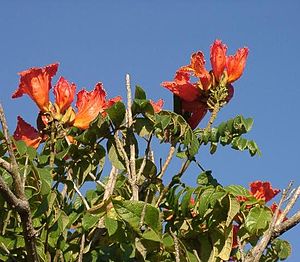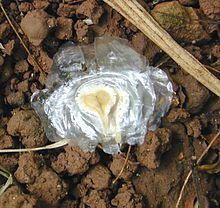African tulip tree
| African tulip tree | ||||||||||||
|---|---|---|---|---|---|---|---|---|---|---|---|---|

African tulip tree ( Spathodea campanulata ) |
||||||||||||
| Systematics | ||||||||||||
|
||||||||||||
| Scientific name | ||||||||||||
| Spathodea campanulata | ||||||||||||
| P.Beauv. |
The African tulip tree ( Spathodea campanulata ) is a species of the genus Spathodea within the trumpet tree family (Bignoniaceae).
description
Vegetative characteristics
Spathodea campanulata grows as a semi- evergreen tree and usually reaches heights of up to 25 meters, but specimens with a height of 30 meters have also been reported from West Africa . It grows very quickly and reaches a growth in thickness of the stem axis of around 5 centimeters in diameter per year. The trunk reaches a diameter of up to 90 (to 175) centimeters and is often fluted at the base. The bark is brownish to gray-brown and slightly cracked, furrowed to scaly or flaky.
The opposite or whorled in threes, with a length of 30 to 60 centimeters relatively large leaves are divided into petiole and leaf blade. The petiole is up to 7-15 inches long. The imparipinnate leaf blade contains 5 to 19 thin-leaved leaflets . The sedentary to short-stalked, pointed to pointed and entire-margined leaflets are 6.5 to 15 inches long and 3.5 to 7.5 inches wide. They are ovate to obovate or elliptical. The underside of the leaflet is slightly rust-colored and hairy ( indument ) and glands can be formed at the base. The stipules are missing.
Generative characteristics
Spathodea campanulata blooms for the first time when it is three to four years old. The flowers stand together in a terminal racemose inflorescence .
The hermaphroditic, large and stalked flowers are zygomorphic and five-fold with a double flower envelope . The flower stalk is up to 6 inches long. The ribbed, pointed and 4–8 cm long, velvety hairy sepals are brownish, with dark points and are sickle, horn-shaped and spathe -shaped , with a slit on the back through which the crown unfolds. The red-yellowish, overgrown crown is up to 10-15 centimeters long and wide-bell-shaped with five short lobes and a narrowed base. The four didynamic and fertile, somewhat protruding stamens are light yellow except for the brown anthers . The two-chamber ovary is upper constant with a thread-like, slightly protruding stylus with zweilappiger scar .
The two-lobed and multi-seeded (500), woody, dark brown, pointed as well as laterally flattened, ovoid and upright capsule fruit is up to 15-25 centimeters long and 3.5-7 centimeters wide. The flat, thin and winged seeds are light brown and very light. The large, fine and membranous, approximately semicircular wing is almost transparent.
Occurrence
Spathodea campanulata grows naturally in tropical secondary forests in the highlands, as well as in tropical deciduous forests , savanna forests , and transitional forests .
The natural distribution area runs along the African Atlantic coast from Ghana to the south to Angola and from there through the humid inland areas of the continent to Sudan and Uganda . The northern limit of the distribution area is the 12th north latitude and the southern limit is the 12th south latitude.
Because of its attractive flowers, the African tulip tree is also cultivated as an ornamental plant in many places outside Africa and has become overgrown, so that there are many neophytic occurrences today. These include: Colombia , Costa Rica, Puerto Rico , Cuba, Jamaica , Hawaii, Sri Lanka, and Guam .
use
The soft wood of Spathodea campanulata is used in part for paper production and carpentry.
The leaves, its flowers and also pieces of bark are used in folk medicine to prepare remedies against skin diseases.
The seeds should be edible. The unopened flower buds contain a sweet, watery liquid that is considered a tonic.
Because of its attractive flowers, the African tulip tree is also cultivated as an ornamental plant in many places .
literature
- KF Connor, JK Francis: Spathodea campanulata. In: JA Vozzo: Tropical Tree Seed Manual. rngr.net ( Memento of April 27, 2005 in the Internet Archive ) (PDF).
- Johna K. Francis: Spathodea campanulata Beauv. Tulipán africano. USDA Forest Service (Ed.) 1990. online (PDF; 202 kB).
- Sébastien Larrue, Curtis C. Daehler, Franck Vautier, Jennifer L. Bufford: Forest Invasion by the African tulip tree (Spathodea campanulata) in the Hawaiian Islands: Are Seedlings Shade-Tolerant? In: Pacific Science. 68 (3), University of Hawaii Press, 2014, pp. 345–358, hal-01122865, doi: 10.2984 / 68.3.4 , online (PDF), at Archive ouverte HAL.
Individual evidence
- ↑ Spathodea campanulata at Useful Tropical Plants.
Web links
- Spathodea campanulata at PROTA.
- African tulip tree in arboriculture.
- Spathodea campanulata at Pitchandikulam Forest Virtual Herbarium (pictures).
- Spathodea campanulata in the Germplasm Resources Information Network (GRIN), USDA , ARS , National Genetic Resources Program. National Germplasm Resources Laboratory, Beltsville, Maryland. Retrieved December 18, 2018.
- Rafaël Govaerts (Ed.): Spathodea campanulata. In: World Checklist of Selected Plant Families (WCSP) - The Board of Trustees of the Royal Botanic Gardens, Kew . Retrieved December 18, 2018.
- Genus Spathodea at Multilingual Multiscripted Plant Name Database (MMPND)



